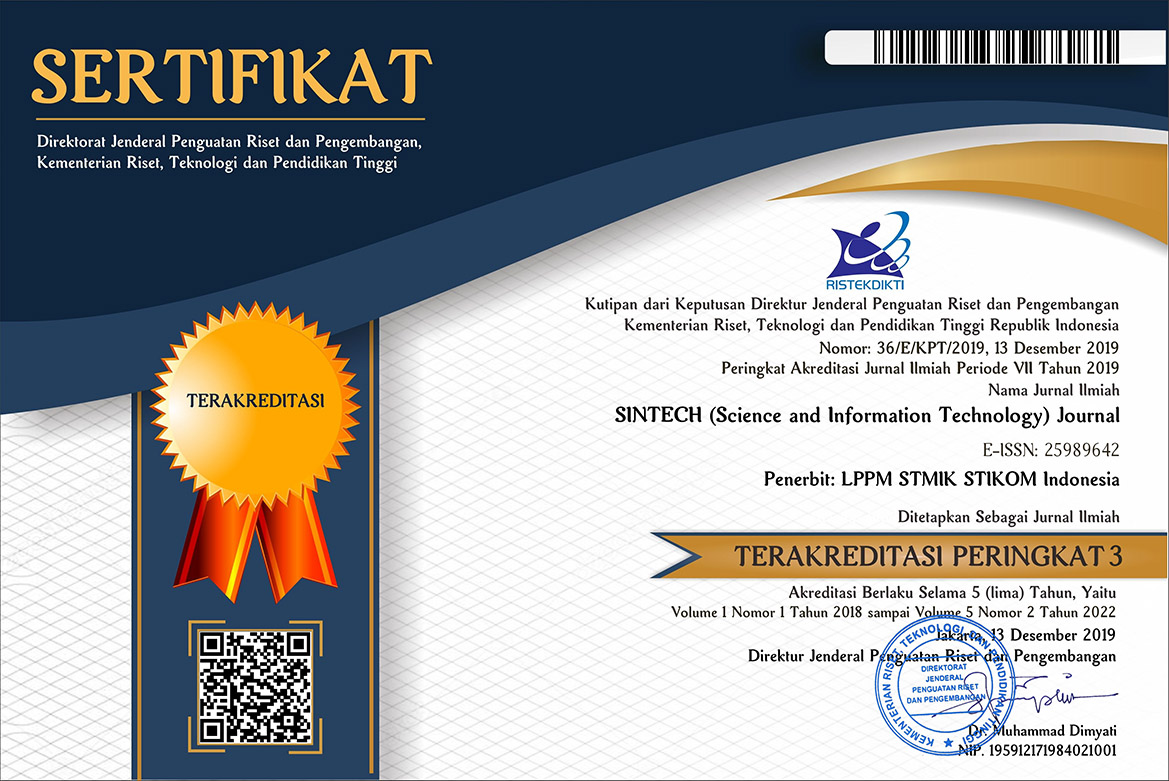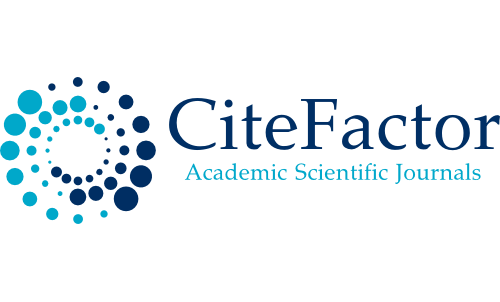IMPLEMENTASI GOOGLE DRIVE CLOUD STORAGE PADA SISTEM REPOSITORI AL-DARING
DOI:
https://doi.org/10.31598/sintechjournal.v5i1.1000Keywords:
Information Systems, Google Drive Cloud Storage, Google Drive APIAbstract
One of the steps of accreditation for institutions and study programs during the epidemic is online assessment (AL-Daring). The availability of suitable information and communication technologies to enable the AL-Daring process is one of the consequences of AL-Daring. Supporting data must be provided in the form of a soft copy in the University Information System that assessors may access appropriately. How the Information System can help Study Program Managers and Accreditation Applicants complete documentation more quickly and efficiently is also crucial. It's also important to note that each Study Program and Study Program Manager will upload a large number of papers of various types and sizes. As a result, various factors that affect the quality of information systems, such as data and storage space availability, ease of access, and timeliness, must be satisfied. The AL-Daring Information System is being developed using agile methodologies in the aim of completing it faster so that it can be utilized right away and adapt to user needs. To perform successfully, this system was built using the Codeigniter framework and Google Drive Cloud Storage as a document storage medium via the Google Drive API service. SUS rates the repository system an excellent score on an adjective rating claiming the system is very useful and well-received by users.
Downloads
References
Undang-Undang Republik Indonesia No 12 Tahun 2012, UNDANG-UNDANG REPUBLIK INDONESIA NOMOR 12 TAHUN 2012 TENTANG PENDIDIKAN TINGGI. 2012.
A. Primadewi and M. Hanafi, “Pengelolaan Data Terintegrasi Berdasarkan Instrumen Akreditasi Perguruan Tinggi 3.0 Menggunakan Zachman Framework,” J. RESTI (Rekayasa Sist. dan Teknol. Informasi), vol. 4, no. 6, pp. 5–10, 2020.
B. Akreditasi and N. Perguruan, “Panduan Asesmen Lapangan Secara Daring,” no. September, 2020.
A. Kamran, L. Happy, and T. Palysu, “Pengembangan Sistem Informasi Repository Data Akreditasi Institut Teknologi Kalimantan,” vol. 6, no. 2, pp. 200–209, 2020.
N. R. Radliya and R. Sidik, “Rancang Bangun Sistem Repository Akreditasi Program Studi Manajemen Informatika,” J. Manaj. Inform., vol. 8, no. 2, 2018.
M. R. Haroki, H. Ajie, and M. fick. Duskarnaen, “Pengembangan Sistem Repositori Dokumen Akreditasi Institusi Perguruan Tinggi di Universitas Negeri Jakarta.pdf.” PINTER, Jakarta, 2019.
I. Sontana, A. Rahmatulloh, and A. N. Rachman, “Application Programming Interface Google Picker Sebagai Penyimpanan Data Sistem Informasi Arsip Berbasis Cloud,” J. Nas. Teknol. dan Sist. Inf., vol. 5, no. 1, pp. 25–32, 2019.
G. Kulkarni, R. Sutar, and J. Gambhir, “‘ Cloud Computing - Storage as Service ,’” Int. J. Eng. Res. Appl., vol. 2, no. 1, pp. 945–950, 2012.
P. A. Abdalla, “Advantages to Disadvantages of Cloud Computing for Small-Sized Business,” in International Symposium on Digital Forensics and Security (ISDFS), 2019.
J. Wu, L. Ping, X. Ge, W. Ya, and J. Fu, “Cloud storage as the infrastructure of Cloud Computing,” Proc. - 2010 Int. Conf. Intell. Comput. Cogn. Informatics, ICICCI 2010, pp. 380–383, 2010.
S. Tata et al., “Quick access: Building a smart experience for google drive,” Proc. ACM SIGKDD Int. Conf. Knowl. Discov. Data Min., vol. Part F1296, pp. 1643–1651, 2017.
Google Developers, “Introduction to Google Drive API,” Google. [Online]. Available: https://developers.google.com/drive/api/v2/about-sdk. [Accessed: 01-Jun-2021].
K. Ibnutama, H. Winata, and M. Hutasuhut, “Web-Based College Student Assignment File Collection Application Using Google Drive API,” vol. 3, no. 2, pp. 34–40, 2019.
A. Bangor, P. T. Kortum, and J. T. Miller, “An Empirical Evaluation of the System Usability Scale,” Int. J. Human–Computer Interact., vol. 24, no. 6, pp. 574–594, Jul. 2008.
B. Beny, H. Yani, and G. M. Ningrum, “Evaluasi Usability Situs Web Kemenkumham Kantor Wilayah Jambi dengan Metode Usability Test dan System Usability Scale,” Res. Comput. Inf. Syst. Technol. Manag., vol. 2, no. 1, p. 30, 2019.
V. Venkatesh, J. Y. L. Thong, F. K. Y. Chan, H. Hoehle, and K. Spohrer, “How agile software development methods reduce work exhaustion: Insights on role perceptions and organizational skills,” Inf. Syst. J., vol. 30, no. 4, pp. 733–761, 2020.
S. Ghobadi and L. Mathiassen, “Perceived barriers to effective knowledge sharing in agile software teams,” Inf. Syst. J., vol. 26, no. 2, pp. 95–125, 2016.
F. Anwer, S. Aftab, S. Shah Muhammad Shah, U. Waheed, S. M. Shah, and U. Waheed, “Comparative analysis of two popular agile process models: extreme programming and scrum,” Int. J. Comput. Sci. Telecommun., vol. 8, no. 2, pp. 1–7, 2017.
K. A. Seputra and G. Sandiasa, “Rancang Bangun Sistem Informasi Satgas Gotong Royong (Si Garong) Desa Adat Berbasis Mobile,” J. Nas. Pendidik. Tek. Inform., vol. 9, no. 3, p. 338, 2020.
M. Larassati, A. Latukolan, A. Arwan, and M. T. Ananta, “Pengembangan Sistem Pemetaan Otomatis Entity Relationship Diagram Ke Dalam Database,” J. Pengemb. Teknol. Inf. dan Ilmu Komput., vol. 3, no. 4, pp. 4058–4065, 2019.
A. Bangor, T. Staff, P. Kortum, J. Miller, and T. Staff, “Determining what individual SUS scores mean: adding an adjective rating scale,” J. usability Stud., vol. 4, no. 3, pp. 114–123, 2009.
Downloads
Published
How to Cite
Issue
Section
License
Copyright (c) 2022 Ketut Agus Seputra, A.A. Gede Yudhi Paramartha, I Nyoman Saputra Wahyu Wijaya

This work is licensed under a Creative Commons Attribution-NonCommercial-ShareAlike 4.0 International License.
Copyright in each article belongs to the author.
- The authors admit that SINTECH Journal as a publisher who published the first time under
 Attribution-NonCommercial-ShareAlike 4.0 International (CC BY-NC-SA 4.0) License.
Attribution-NonCommercial-ShareAlike 4.0 International (CC BY-NC-SA 4.0) License. - Authors can include writing separately, regulate distribution of non-ekskulif of manuscripts that have been published in this journal into another version (eg sent to respository institution author, publication into a book, etc.), by recognizing that the manuscripts have been published for the first time in SINTECH Journal















1.png)




